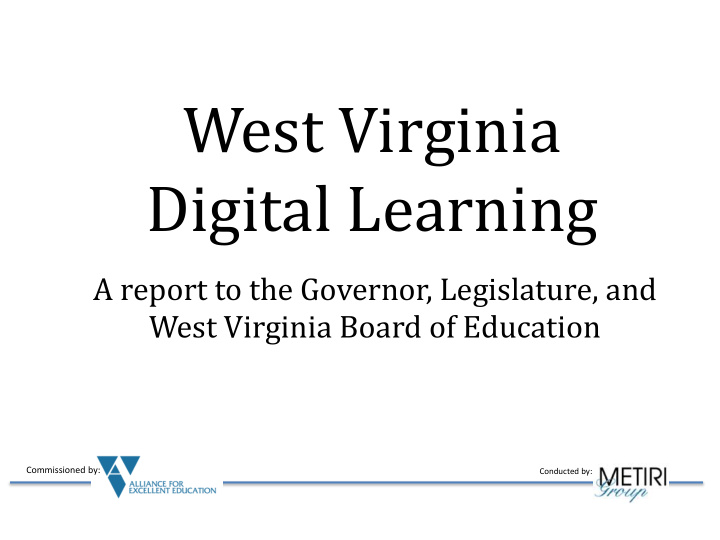



West Virginia Digital Learning A report to the Governor, Legislature, and West Virginia Board of Education Commissioned by: Conducted by:
The Study What: A study of digital learning in West Virginia Why: To gauge the readiness of WV districts for digital learning To gauge the current state of school implementation of digital learning To identify actions to improve WV readiness for digital learning How: A synthesis of five data sets: 1. 55 county districts, 2 state districts’ P24 self -assessments 2. Fall 2013 statewide teacher survey (n=1371) 3. Fall 2013 statewide school administrator survey (n=92) 4. State inventories of technology (WVDOE) 5. Fall 2013 interviews with stakeholders Commissioned by: Conducted by:
West Virginia is the first state in the nation to conduct a statewide Project 24 audit. Commissioned by: Conducted by:
An evolving state vision… “With today’s technological advances, we have the ability to personalize learning and better meet the needs of each individual student.” - Governor Earl Ray Tomblin A Vision from one WV District: “All teachers and students have access to a variety of technology and digital content with which to create, communicate and collaborate locally and globally. Learning is engaging, personalized, and authentic to enable students to become college and career ready, as well as confident, creative, active, and informed citizens of the 21st century .” Commissioned by: Conducted by:
The Study framework: PROJECT 24 The Gears Represent: Readiness for digital Learning Commissioned by: Conducted by:
P24: District Readiness for Digital Learning in WV Chart denotes district readiness to implement, not current status. Source: 55 County School District and 2 State School District Leadership Teams’ P24 Data Commissioned by: Conducted by:
Schools’ Current Status: Digital Learning in WV See the full report for additional statistics. 93% of school 61% of teachers say 38% of school Only 14% administrators say that Yet… they are not provided with administrators disagree of school district “Teachers are expected to with the statement: “The time to work together to leadership teams say that transition to digital redesign lessons related to Internet connection in our district policies and plans learning.” deeper learning/21 st school is fast and are in place to support reliable. ” Century skills. personalized learning N=92 School Administrators N=1371 Teachers N=92 School Administrators N=57 School District teams Commissioned by: Conducted by:
Access & Infrastructure Even with the leading indicator, there is much work yet to be accomplished… Figure 1: Degree to which school administrators agreed with the following statements: Internet Access: The Internet connection 18% 20% 49% 13% Strongly disagree in our school is fast and reliable Disagree Device Access: Access to devices is 20% 23% 41% 16% sufficient to meet learning needs Agree Strongly Agree Technical Support: Technical support in 14% 20% 53% 13% my school is timely and responsive Source: 92 School Administrators 0% 20% 40% 60% 80% 100% Commissioned by: Conducted by:
The Study Results DISTRICT READINESS: Most districts have set digital learning as a target, have researched what will be required to transition to digital learning, and are in the planning stages. Their vision of personalized, anywhere, anytime, digital learning will require new state policies in each of the P24 gears that enable new designs for learning. Commissioned by: Conducted by:
The Study Results SCHOOLS’ CURRENT STATUS: While schools recognize the need to shift to the new vision for digital learning, most are in the beginning stages. The data indicate that today, there is not yet a common understanding of what digital learning entails, structures are not in place to enable digital learning, and thus, implementation is more the exception than the rule. Commissioned by: Conducted by:
Recommend
More recommend